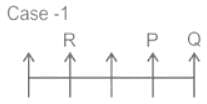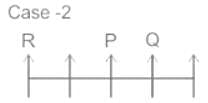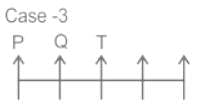Test: Data Sufficiency- 1 - CAT MCQ
25 Questions MCQ Test Logical Reasoning (LR) and Data Interpretation (DI) - Test: Data Sufficiency- 1
Directions to Solve: In each of the questions below consists of a question and two statements numbered I and II given below it. You have to decide whether the data provided in the statements are sufficient to answer the question. Read both the statements and mark the appreciate answer.
Question: In which year was Rahul born?
Statements:
I. Rahul at present is 25 years younger to his mother.
II. Rahul's brother, who was born in 1964, is 35 years younger to his mother.
Statements:
I. Rahul at present is 25 years younger to his mother.
II. Rahul's brother, who was born in 1964, is 35 years younger to his mother.
Directions to Solve: In each of the questions below consists of a question and two statements numbered I and II given below it. You have to decide whether the data provided in the statements are sufficient to answer the question. Read both the statements and mark the appreciate answer.
Question: What will be the total weight of 10 poles, each of the same weight?
Statements:
I. One-fourth of the weight of each pole is 5 kg.
II. The total weight of three poles is 20 kilograms more than the total weight of two poles.
Statements:
I. One-fourth of the weight of each pole is 5 kg.
II. The total weight of three poles is 20 kilograms more than the total weight of two poles.
Directions to Solve: In each of the questions below consists of a question and two statements numbered I and II given below it. You have to decide whether the data provided in the statements are sufficient to answer the question. Read both the statements and mark the appreciate answer.
Question: How many children does M have?
Statements:
I. H is the only daughter of X who is wife of M.
II. K and J are brothers of M.
Statements:
I. H is the only daughter of X who is wife of M.
II. K and J are brothers of M.
Given below is a question and two statements numbered I and II given below it. You have to decide whether the data provided in the statements is sufficient to answer the question. You should use the given data and your knowledge of Mathematics to choose between the possible answers.
Question: Is a number T divisible by 144?
Statements:
I. T is a multiple of 216.
II. T is divisible by square of cube of 2.
Directions to Solve: In each of the questions below consists of a question and two statements numbered I and II given below it. You have to decide whether the data provided in the statements are sufficient to answer the question. Read both the statements and mark the appreciate answer.
Question: How much was the total sale of the company?
Statements:
I. The company sold 8000 units of product A each costing Rs. 25.
II. This company has no other product line.
Directions to Solve: In each of the questions below consists of a question and two statements numbered I and II given below it. You have to decide whether the data provided in the statements are sufficient to answer the question. Read both the statements and mark the appreciate answer.
Question: The last Sunday of March, 2006 fell on which date?
Statements:
I. The first Sunday of that month fell on 5th.
II. The last day of that month was Friday.
Directions to Solve: In each of the questions below consists of a question and two statements numbered I and II given below it. You have to decide whether the data provided in the statements are sufficient to answer the question. Read both the statements and mark the appreciate answer.
Question: How many children are there between P and Q in a row of children?
Statements:
I. P is fifteenth from the left in the row.
II. Q is exactly in the middle and there are ten children towards his right.
Directions to Solve: In each of the questions below consists of a question and two statements numbered I and II given below it. You have to decide whether the data provided in the statements are sufficient to answer the question. Read both the statements and mark the appreciate answer.
Question: How is J related to P?
Statements:
I. M is brother of P and T is sister of P.
II. P's mother is married to J's husband who has one son and two daughters.
Directions to Solve: In each of the questions below consists of a question and two statements numbered I and II given below it. You have to decide whether the data provided in the statements are sufficient to answer the question. Read both the statements and mark the appreciate answer.
Question: How is T related to K?
Statements:
I. R's sister J has married T's brother L, who is the only son of his parents.
II. K is the only daughter of L and J.
Directions to Solve: In each of the questions below consists of a question and two statements numbered I and II given below it. You have to decide whether the data provided in the statements are sufficient to answer the question. Read both the statements and mark the appreciate answer.
Question: How is X related to Y?
Statements:
I. Y and Z are children of D who is wife of X.
II. R's sister X is married to Y's father.
Directions to Solve: In each of the questions below consists of a question and two statements numbered I and II given below it. You have to decide whether the data provided in the statements are sufficient to answer the question. Read both the statements and mark the appreciate answer.
Question: Who is to the immediate right of P among five persons P, Q, R, S and T facing North?
Statements:
I. R is third to the left of Q and P is second to the right of R.
II. Q is to the immediate left of T who is second to the right of P.
Directions to Solve: In each of the questions below consists of a question and two statements numbered I and II given below it. You have to decide whether the data provided in the statements are sufficient to answer the question. Read both the statements and mark the appreciate answer.
Question: On which date of the month was Anjali born in February 2004?
Statements:
I. Anjali was born on an even date of the month.
II. Anjali's birth date was a prime number.
Directions to Solve: In each of the questions below consists of a question and two statements numbered I and II given below it. You have to decide whether the data provided in the statements are sufficient to answer the question. Read both the statements and mark the appreciate answer.
Question: How is F related to P?
Statements:
I. P has two sisters M and N.
II. F's mother is sister of M's father.
Directions to Solve: In each of the questions below consists of a question and two statements numbered I and II given below it. You have to decide whether the data provided in the statements are sufficient to answer the question. Read both the statements and mark the appreciate answer.
Question: How is X related to Y?
Statements:
I. Y says, "I have only one brother".
II. X says, "I have only one sister".
Directions to Solve: In each of the questions below consists of a question and two statements numbered I and II given below it. You have to decide whether the data provided in the statements are sufficient to answer the question. Read both the statements and mark the appreciate answer.
Question: B is the brother of A. How is A related to B?
Statements:
I. A is the sister of C.
II. E is the husband of A.
Directions to Solve: In each of the questions below consists of a question and two statements numbered I and II given below it. You have to decide whether the data provided in the statements are sufficient to answer the question. Read both the statements and mark the appreciate answer.
Question: How many children are there in the row of children facing North?
Statements:
I. Vishakha who is fifth from the left end is eighth to the left of Ashish who is twelfth from the right end.
II. Rohit is fifth to the left of Nisha who is seventh from the right end and eighteenth from the left end.
Directions to Solve: In each of the questions below consists of a question and two statements numbered I and II given below it. You have to decide whether the data provided in the statements are sufficient to answer the question. Read both the statements and mark the appreciate answer.
Question: How many doctors are practising in this town?
Statements:
I. There is one doctor per seven hundred residents.
II. There are 16 wards with each ward having as many doctors as the number of wards.
Directions to Solve: In each of the questions below consists of a question and two statements numbered I and II given below it. You have to decide whether the data provided in the statements are sufficient to answer the question. Read both the statements and mark the appreciate answer.
Question: On which day of the week was birthday of Sahil?
Statements:
I. Sahil celebrated his birthday the very next day on which Arun celebrated his birthday.
II. The sister of Sahil was born on the third day of the week and two days after Sahil was born.
Directions to Solve: In each of the questions below consists of a question and two statements numbered I and II given below it. You have to decide whether the data provided in the statements are sufficient to answer the question. Read both the statements and mark the appreciate answer.
Question: How many pages of book X did Robert read on Sunday?
Statements:
I. The book has 300 pages out of which two-thirds were read by him before Sunday.
II. Robert read the last 40 pages of the book on the morning of Monday.
Directions to Solve: In each of the questions below consists of a question and two statements numbered I and II given below it. You have to decide whether the data provided in the statements are sufficient to answer the question. Read both the statements and mark the appreciate answer.
Question: How is Tanya(girl) related to the man in the photograph?
Statements:
I. Man in the photograph is the only son of Tanya's grandfather.
II. The man in the photograph has no brothers or sisters and his father is Tanya's grandfather.
Directions to Solve: In each of the questions below consists of a question and two statements numbered I and II given below it. You have to decide whether the data provided in the statements are sufficient to answer the question. Read both the statements and mark the appreciate answer.
Question: Among T, V, B, E and C, who is the third from the top when arranged in the descending order of their weights?
Statements:
I. B is heavier than T and C and is less heavier than V who is not the heaviest.
II. C is heavier than only T.
Directions to Solve: In each of the questions below consists of a question and two statements numbered I and II given below it. You have to decide whether the data provided in the statements are sufficient to answer the question. Read both the statements and mark the appreciate answer.
Question: Which word in the code language means 'flower'?
Statements:
I. 'de fu la pane' means 'rose flower is beautiful' and 'la quiz' means 'beautiful tree'.
II. 'de la chin' means 'red rose flower' and 'pa chin' means 'red tea'.
Given below is a question and two statements numbered I and II given below it. You have to decide whether the data provided in the statements is sufficient to answer the question. You should use the given data and your knowledge of Mathematics to choose between the possible answers.
Question: X, Y and Z are integers. Is X an odd number?
Statements:
I. An odd number is obtained when X is divided by 5.
II. X + Y is an odd number.
Directions to Solve: In each of the questions below consists of a question and two statements numbered I and II given below it. You have to decide whether the data provided in the statements are sufficient to answer the question. Read both the statements and mark the appreciate answer.
Question: How many students in a class play football?
Statements:
I. Only boys play football.
II. There are forty boys and thirty girls in the class.
Directions to Solve: In each of the questions below consists of a question and two statements numbered I and II given below it. You have to decide whether the data provided in the statements are sufficient to answer the question. Read both the statements and mark the appreciate answer.
Question: On a T.V. channel, four serials A, B, C, and D were screened, one on eacn days, on four consecutive days but not necessarily in that order. On which day was serial C screened?
Statements:
I. The first serial was screened on 23rd, Tuesday and was followed by serial D.
II. Serial A was not screened on 25th and one serial was screened between serials A and B.
|
92 videos|123 docs|94 tests
|
|
92 videos|123 docs|94 tests
|

























